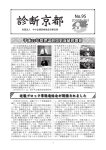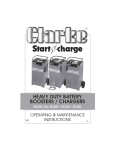Download Clarke BC 700 Instruction manual
Transcript
BATTERY BOOSTER/CHARGER MODEL No. BC 700 Par t No.6260025 OPERATING & MAINTENANCE INSTRUCTIONS Congratulations on the purchase of your new CLARKE, START ‘N CHARGE 700, BATTERY BOOSTER/CHARGER. This 3 Phase unit is suitable for charging and boosting 12 and 24 Volt lead acid batteries. Before attempting to operate this unit, please read this instruction manual thoroughly, and follow all directions carefully. By doing so you will ensure the safety of yourself, and others around you, and at the same time, you should look forward to the unit giving long and trouble free service. GUARANTEE This CLARKE product is guaranteed against faulty manufacture for a period of 12 months from the date of purchase. Please keep your receipt as proof of purchase. This guarantee is invalid if the product is found to have been abused or tampered with in any way, or not used for the purpose for which it was intended. Faulty goods should be returned to their place of purchase, no product can be returned to us without prior permission. This guarantee does not effect your statutory rights. CONTENTS IMPORTANT: SAFETY PRECAUTIONS ............................................................. 3 ELECTRICAL CONNECTIONS .......................................................................... 4 PROCEDURE FOR NORMAL CHARGING Ref. Fig. 1 ........................................ 5 FAST CHARGING WITH TIMER ........................................................................ 5 PROCEDURE FOR ENGINE STARTING ............................................................. 6 PARTS LIST ..................................................................................................... 8 PARTS DRAWING ............................................................................................ 9 WIRING DIAGRAM ......................................................................................... 10 SPECIFICATIONS ........................................................................................... 11 -2- IMPORTANT: SAFETY PRECAUTIONS PLEASE READ BEFORE USING THIS UNIT 1. WARNING: Some electronic equipment can be damaged by boost charging or use of start facility. Check your vehicle handbook before using your Start ‘N Charge. If in doubt consult the vehicle manufacturer. Nevertheless, you should not operate this equipment unless you are fully conversant with vehicle electrical systems, and battery charging techniques. 2. WARNING: Because highly inflammable hydrogen gas is released in the process of battery charging, please remember to switch OFF the charger first, and so avoid sparking which will occur when CONNECTING OR DISCONNECTING LIVE LEADS. 3. Black negative (-) lead must always be clipped to the negative, and Red positive (+) lead must always be clipped to the positive. When charging with battery installed in vehicle, or boosting, first connect the appropriate lead to the UNEARTHED battery terminal (on most modern cars this is the positive (+) terminal), then connect the other lead to the chassis (or a suitable engine bolt) away from the battery and fuel line. It is advisable to disconnect the unearthed terminal from the battery, when charging in situ. To stop charging/boosting, turn the Charging Controller to the “O” (OFF) position, and then disconnect the chassis lead, and battery lead, in that order. 4. To prevent battery overheating and consequent damage, use the BOOST facility sparingly and do not exceed our recommendations. 5. Battery acid is highly corrosive. If spillage occurs, wipe off immediately and wash copiously with water. Particularly avoid contact with the eyes, but if this occurs, you must seek medical advice. 6. When charging is completed, ensure that the vehicle battery leads are secured to the proper terminals which should be clean and lightly smeared with petroleum jelly to prevent corrosion. Finally, re-check the electrolyte level. 7. Do not expose this unit to rain. 8. Never touch together the negative and positive leads on this unit whilst the unit is switched on. 9. Never attempt any electrical or mechanical repair. If you have a problem with your machine contact your local stockist for service information. 10. WARNING: Certain types of sealed or maintenance-free batteries need extra care when charging. Please consult battery manufacturers instructions before using this unit. 11. WARNING: Since toxic fumes may be released during battery charging, ONLY USE THIS UNIT IN A WELL VENTILATED AREA. -3- 12. Before charging ensure the battery terminals are clean and that the cells are filled with electrolyte to the correct level by adding distilled water where necessary. 13. Where appropriate we recommend that the vehicles’ positive (+) lead to the battery is disconnected on the prior to charging. ELECTRICAL CONNECTIONS This equipment MUST be connected to a 3 phase supply, through a suitable plug. If connection is done through an isolator, it is recommended that you consult a qualified electrician. Under no circumstances must this equipment be connected to a standard 230 Volt, 1 phase supply i.e., through a 13 Amp plug. IMPORTANT: The wires in the mains lead are coloured in accordance with the following code: Green & Yellow - Earth Blue - Line 3 PHASES Brown - Line Black - Line FIG. 1 1. Timer Control Knob 2. Green Pilot Light - Timer 3. Ammeter 4. Line Voltage Lamp 5. Voltmeter 6. Charging Controller 7. Voltage Selector Switch 8. Current Controller 9. Positive and Negative Lead 1 2 3 4 5 6 10. Power Input 9 -4- 7 8 10 PROCEDURE FOR NORMAL CHARGING Ref. Fig. 1 1. Check that the Charging Controller (6) is in the “O” (OFF) position. 2. Connect the appropriate lead to the unearthed battery terminal (on most modern vehicles, this is the positive (+ve) terminal), then connect the other lead to the chassis (or a suitable engine bolt) away from the battery and fuel line. REMEMBER, Positive to Positive, Negative to Negative. 3. Select, via Voltage Selector switch (7), the appropriate voltage required (12V or 24V), which will be indicated on the voltmeter (5). 4. Switch ON the Charging Controller (6) to SLOW position. 5. Turn the current controller (8), clockwise to a position between 1 and 6 so as to obtain the desired charging rate as indicated on the ammeter (3). FAST CHARGING WITH TIMER 1. Follow the same instructions as for NORMAL CHARGING, up to and including paragraph (c). 2. Turn the timer control knob (1) clockwise to the desired charging time setting. 3. Switch ON the Charging Controller (6) to fast position. 4. Turn the current controller (8) clockwise to position 5 or 6 so as to obtain the desired charging rate as indicated on the ammeter(3). NOTES 1. A complete charge is best done slowly, so in this case we recommend that the charging rate (Amps) should not exceed 10% of the battery capacity rating (Ampere Hour) i.e. a normal car battery has Ampere Hour rating of approximately 40 A.H. so the charging rate should not exceed 4 Amps (a complete charge should therefore, take approximately 10 hours). A slow charge rate will also extend the life of the battery. 2. If a low current reading is obtained at any setting, this may indicate that the battery is either (a) already fully charged, or (b) at the end of its useful life and in need of replacement. Check the SG of the battery with a hydrometer to check its condition. 3. DO NOT exceed a charging rate of 80 Amps. -5- PROCEDURE FOR ENGINE STARTING NORMAL The BC 700 is provided with a PCB which allows the constant control on the output voltage of the electromechanical battery chargers during the boost start. Through this system it is possible to avoid damages to the electronic devices of the new generation vehicles when the boost start reaches its voltage peak. We recommend, that before attempting to boost start, you “fast charge” the battery for 10-15 minutes. This will improve the chance of a first time start, particularly with big engines. When the battery is completely flat, you must “fast charge” the battery before attempting to start, otherwise you may cause damage to the vehicles’ electronic system. (a) Ensure that the Charging Controller is in the “O” (OFF) position. (b) Connect the cables as for normal charging. (c) Turn the Charging Controller switch (item 1) clockwise to the “CPS” position ( “START” position for starting without CPS system) and hold, for a few seconds only, before attempting to start the engine in the normal way. The CPS PCB activates the battery charger/starter so as to give to the starter enough current for the time necessary to start the machine motor. This CPS PCB in fact controls the boosting current supply and when it recognizes the current need, it automatically activates the Boost start function. For the same principle when the battery voltage reaches (at the battery end) the safety values, the boost function automatically stops. On full batteries (charged) the battery charger / starter does not even work at boost function. Should starting prove to be at all difficult, it is recommended that you charge the battery at 20 Amps for 10-15 minutes before further attempts at BOOST starting. If in doubt consult vehicle handbook or manufacturer. The boost start function with remote control is replaced on the Autostar models by the boost start through CPS. IMPORTANT: 1. If the fixed positive lead and the fixed negative lead are connected to the wrong terminals, then a flash will occur when the 2nd clamp is attached. Damage to the charging unit and the battery will be avoided as your Clarke START ‘N CHARGE is fitted with a polarity protection feature. It will however be necessary to replace the internal fuse. Remove the cover plate at the back of the unit (marked fuse) and replace the burnt fuse with an exact replacement. -6- 2. This battery charger is designed to charge either 12V or 24V lead acid automotive batteries. Do not attempt recharge any other type of battery. Do not use the battery charger as a power source, eg., to run 12V power tools etc. NOTES: If the START ‘N CHARGE is overloaded at any time a thermal cutout will automatically come into operation and render it inoperative. This is purely a self-protecting device and normal operation can be resumed after a period of several minutes as soon as the unit resets itself. -7- PARTS LIST No. Description 1 2 3 4 5 6 7 8 9 10 11 12 13 14 15 16 17 18 19 20 21 22 23 24 25 26 27 28 29 30 31 32 33 34 Cable Clamp Switch 20A Switch 63A Microswitch Timer Switch 20A Green Pilot-Light Ammeter Green Pilot-Light Voltmeter Contactor Auxiliary Transformer Housing Assembly Red Charging Cable 25mm² 3 m Black Charging Cable 25mm² 3 m CPS Control P.C. Board Complete Thermostat 100° Upper Panel Fuse Cover Volatge Change Board Transformer Fuse Shunt Rectifier Wheels Axle Timer Knob Potentiometer Knob d.48 Potentiometer Knob d.34 Input Cable m 4 Control Panel Side Winding Central Winding Wheel Earth Clamp -8- Part No. EM21605010 EM22205017 EM22205093 EM22200031 EM22215001 EM22205132 EM22610003 EM22600021 EM22610008 EM22605004 EM22225004 EM44140001 EM33700711 EM43200020 EM43200021 EM22700016 EM04600113 EM33705013 EM33740014 EM21890001 EM44105048 EM22220013 EM22600023 EM22400035 EM55200011 EM21690034 EM21690016 EM21690015 EM20220033 EM33710008 EM44005051 EM44005052 EM21625027 EM22110009 PARTS DRAWING -9- WIRING DIAGRAM - 10 - SPECIFICATIONS Supply voltage (ac)............................400 - 230V 3 Phase Fuse Rating........................................16amp. - 230V Max charge..........................................100amp. Max boost.............................................600amp. Boost/charge volts..............................12/24Volts Internal fuse rating........................... ...500Amps Internal fuse.......................................part no. EM22220013 Duty Cycle.............................................30 sec. ON / 60 sec. OFF PARTS AND SERVICE CONTACTS For Spare Parts and Service, please contact your nearest dealer, or CLARKE International, on one of the following numbers. PARTS & SERVICE TEL: 020 8988 7400 PARTS & SERVICE FAX: 020 8558 3622 or e-mail as follows: PARTS: [email protected] SERVICE: [email protected] - 11 - COD. 77610686














